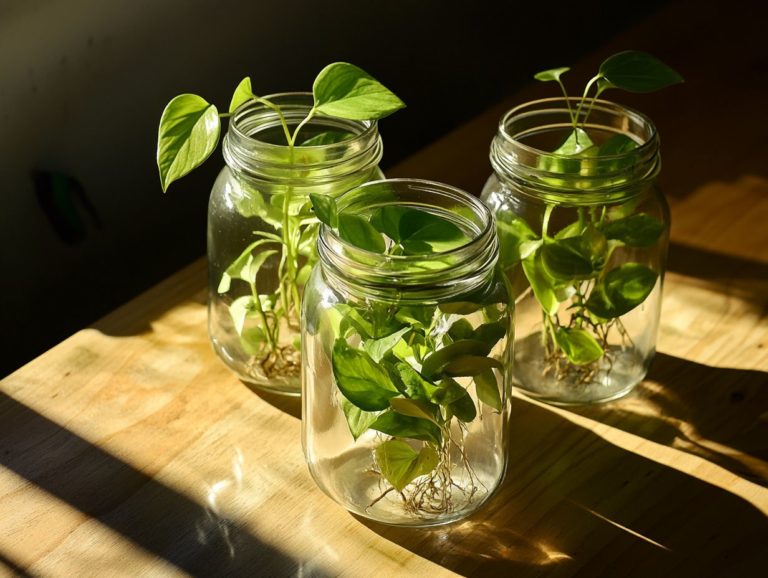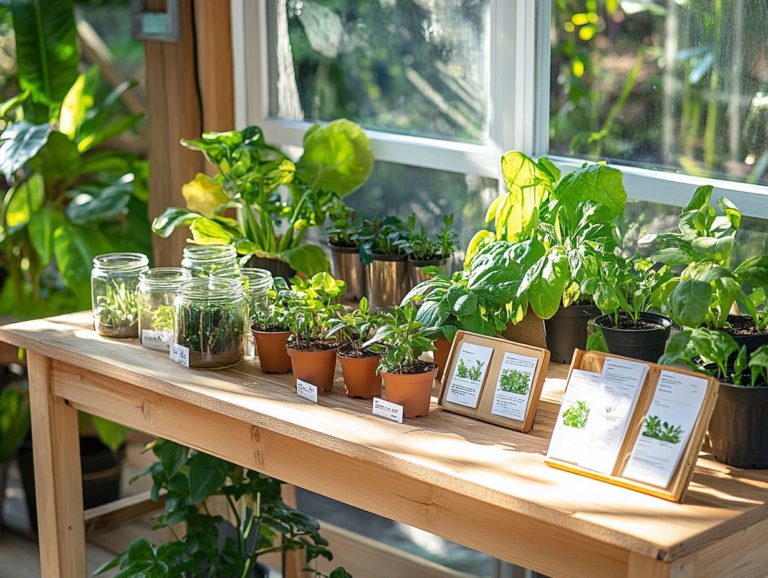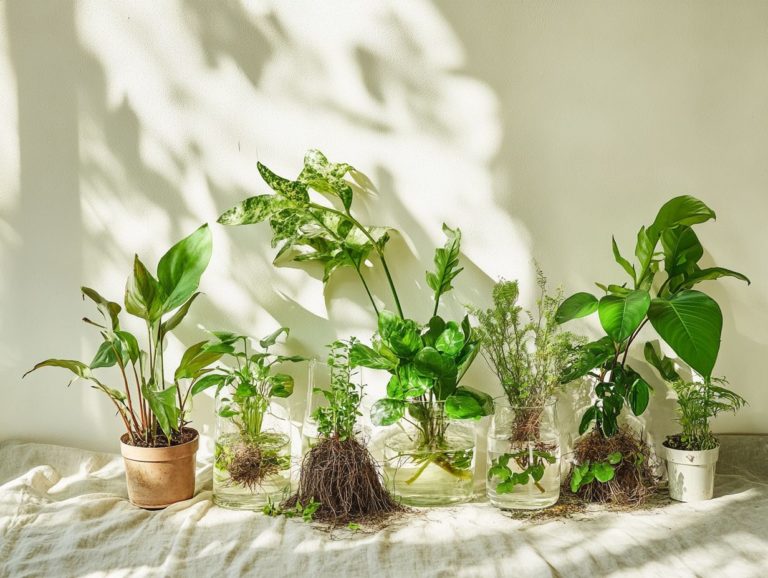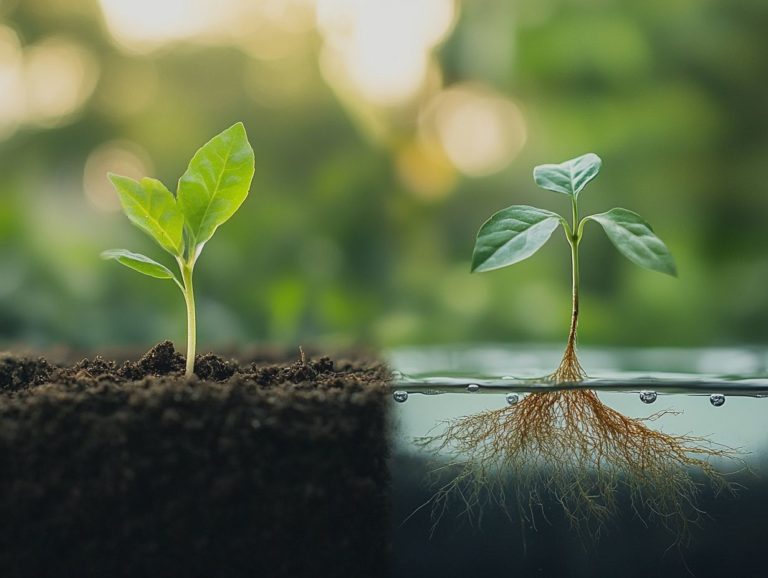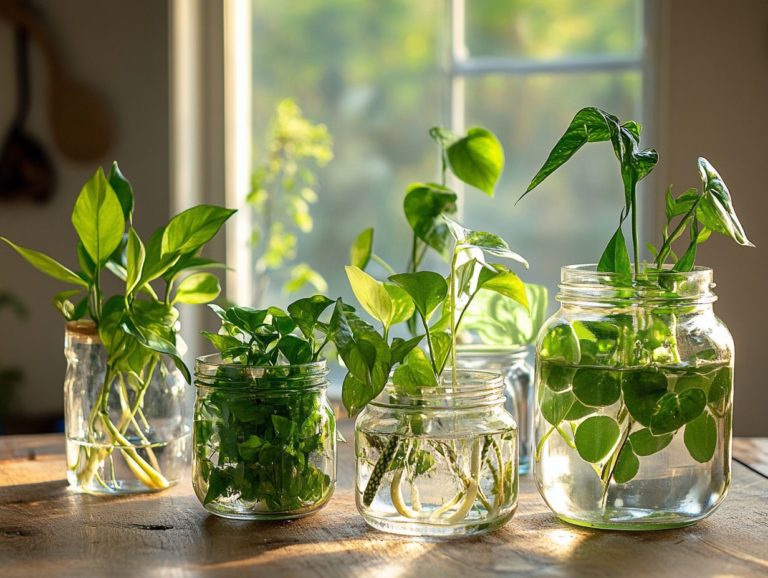The Benefits of Plant Propagation
Plant propagation is an art that empowers you to multiply your favorite plant species with remarkable efficiency, allowing you to create new plants with ease.
Whether your goal is to save a bit of cash, enrich the diversity of your garden, or guarantee the quality of your plants, mastering various propagation techniques is invaluable. Get ready to explore exciting methods of plant propagation!
This article delves into different methods, highlighting the benefits of plant propagation and offering essential tips for success. Prepare to unveil the secrets to nurturing your green space, including effective propagation stations for various species!
Contents
Key Takeaways:
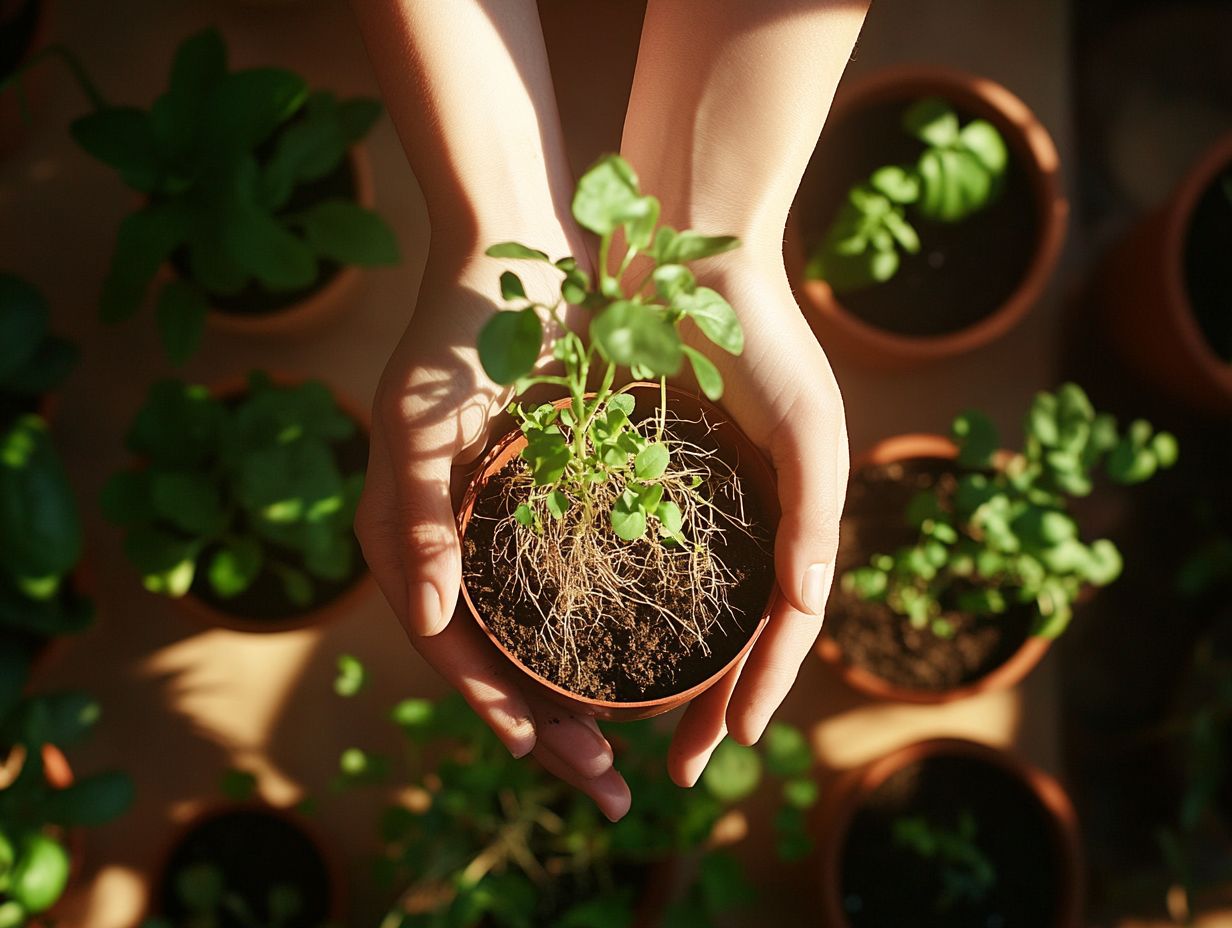
- Plant propagation is the process of reproducing new plants from existing ones, using various methods such as seed, cutting, or division propagation.
- It offers benefits such as cost savings, increased plant diversity, and control over plant quality, making it a practical and enjoyable gardening technique.
- To successfully propagate plants, choose the right plants and provide proper care to ensure healthy growth and development.
What is Plant Propagation?
Plant propagation is your gateway to creating new plants from a variety of sources think seeds, cuttings, or division. It s not just a rewarding hobby for plant lovers; it plays a crucial role in preventing plant extinction by ensuring the survival of different types of plants for future generations. This process allows you to enjoy a seemingly endless supply of plants while making a positive impact on the ecosystem.
By diving into techniques like layering, grafting, and tissue culture (a method of growing new plants in controlled conditions), you can start diversifying your garden today! For example, when you propagate native plants, you’re beautifying your space and helping to restore local habitats, enhancing the environment’s resilience against climate change and invasive species. To learn more about these methods, explore the fascinating world of plant propagation.
Techniques such as division are perfect for perennials, while cuttings work wonders with shrubs and houseplants like Pothos and Monstera. These practices elevate the aesthetic of your green spaces and nurture a vital connection with the planet.
Methods of Plant Propagation
You have a variety of effective methods for plant propagation at your disposal, each presenting its unique advantages and challenges. For instance, you can propagate in water or soil.
Seed propagation is a classic approach, ideal for starting new plants from scratch. For houseplants like Pothos, Monstera, and Snake plant, taking cuttings is a popular choice, allowing you to expand your indoor jungle with ease. Utilizing humidity domes for propagation can enhance this process. Division propagation is a straightforward way to multiply your favorite plants, including herbs like basil and thyme, making it a gardener’s go-to technique for creating more of what they love.
Seed Propagation
Seed propagation is the age-old technique for creating new plants by sowing seeds, and it all starts with understanding which plants will flourish in your environment and the perfect timing for germination.
To kick things off, selecting high-quality seeds is paramount, especially when you consider the growing season in your area. Ensure your choice aligns with the unique climate and soil conditions of your local area for successful propagation. Once you’ve made your selection, preparing the soil is next. This typically involves loosening the ground, enriching it with organic matter, and ensuring proper drainage to encourage vibrant growth.
During the germination phase, it s essential to keep a close eye on moisture levels, along with the ideal temperature and light exposure. Plants like tomatoes, peppers, and herbs such as basil, mint, and rosemary thrive best when you meticulously monitor and adjust their environmental factors.
Now that you have the basics down, don t wait any longer start propagating your plants today!
Cutting Propagation
Cutting propagation is a fascinating process. It involves taking a cutting from plants think houseplants like Spider plants or Swedish ivy and encouraging it to develop new roots.
Using a rooting hormone can significantly enhance success rates, whether you’re propagating in water or soil. This hormone contains compounds that stimulate root growth.
To get started, select a healthy cutting, ideally around 4 to 6 inches long. Make sure it has at least one node, where the roots will emerge.
Dipping the end in rooting hormone can work wonders for root growth. You can find rooting hormone in dry or gel form, making it easier to use.
Many beginners opt for water as a growing medium. It allows for easy monitoring of root growth, which adds to the excitement of propagating houseplants.
On the other hand, propagating in soil provides immediate nutrients for faster growth. Soil can lead to more robust plants once established.
Division Propagation

Division propagation is a simple yet effective technique for creating new plants. You carefully separate sections of a mature plant, making this method perfect for herbs like basil, rosemary, and thyme.
Use clean scissors to minimize damage during the process. Timing is key; perform this technique during the plant’s dormant season typically in early spring or late fall.
Gently lift the plant from its pot while keeping the root system intact. This way, the plant can thrive after being divided.
Once you’ve replanted the divisions, provide fresh soil and enough water. This will boost recovery and growth.
Assess the overall health of the parent plant before starting. This important step ensures the plant can handle the stress of division.
Benefits of Plant Propagation
The advantages of plant propagation are substantial. It creates an opportunity for a highly rewarding experience for gardeners.
One major benefit is significant cost savings. You can grow new plants without spending money at stores.
This practice enhances plant diversity in your garden. It gives you greater control over the quality and health of your plants.
Cost Savings
Plant propagation is a compelling way to save money. You can cultivate new plants at home without financial burdens.
Embrace this practice to expand your green spaces without breaking the bank. Common plants like Pothos, Spider plants, and Succulents are easy to propagate.
Realize that a single store-bought Pothos can cost around $10. Just a few cuttings can yield multiple new plants at no cost, promoting sustainable gardening.
This approach enriches your indoor or outdoor environment. It transforms a costly hobby into an economical and fulfilling endeavor that enhances your relationship with nature.
Increased Plant Diversity
By engaging in plant propagation, you play a crucial role in enhancing plant diversity a key element in preventing plant extinction as you propagate herbs and other valuable species. Get excited about exploring a variety of herbs and selecting the best plants, such as mint and rosemary, suited for your local environment.
This endeavor enriches the ecosystem and helps maintain a delicate balance that benefits various wildlife, from pollinators like bees to birds that depend on diverse food sources. For example, plants like lavender, mint, and echinacea are easy to propagate and attract beneficial insects while supporting soil health, enhancing the resilience of your garden.
Propagating native species like milkweed creates habitats for endangered butterflies, illustrating the profound interconnection between plant life and overall ecosystem vitality. Each successful propagation effort beautifies your garden and contributes to the resilience and sustainability of local flora. To learn more about the advantages and disadvantages of various methods, check out the pros and cons of different propagation techniques.
Control over Plant Quality
Engaging in plant propagation gives you the power to maintain control over the quality of your plants. This ensures that each new addition aligns with your personal standards of health and aesthetics, whether they are herbs or houseplants.
By selecting robust parent plants, such as the fiddle leaf fig and creeping fig, you enhance the overall vigor and resilience of your propagated specimens. It’s essential to closely observe these parent plants for any signs of disease or pest infestations, as these issues can easily transfer to the new plants.
Using sterile tools like clean scissors, understanding the specific needs of various plant species, and creating optimal environmental conditions can dramatically boost your success rate in propagation. This attention to detail enhances the health of your individual plants and contributes to a flourishing garden ecosystem. For more insights, check out the science behind plant propagation. The fruits of your labor will be a testament to both beauty and resilience, showcasing the successful propagation of various plants.
Tips for Successful Plant Propagation
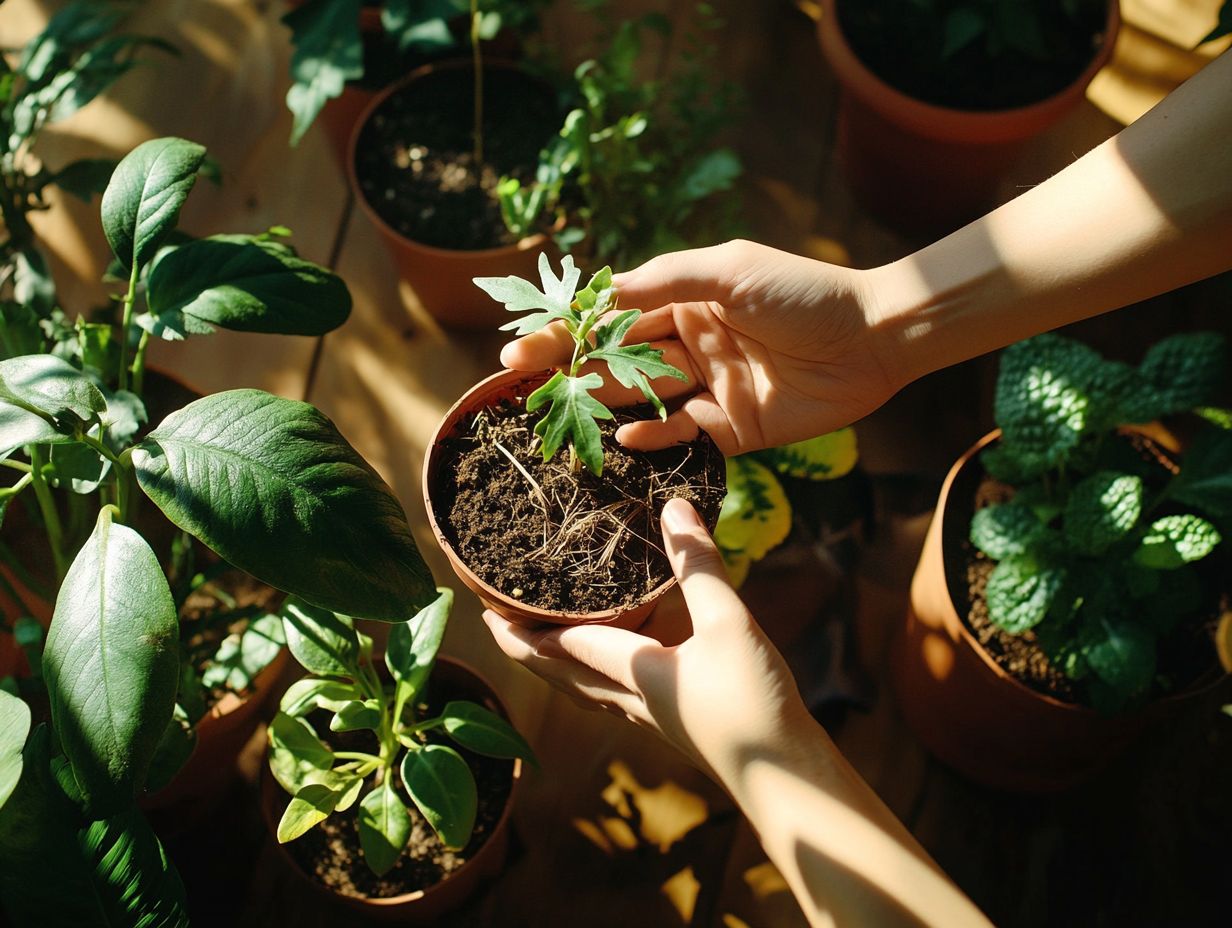
To achieve successful plant propagation, follow these guidelines:
Start by selecting the right plants that align with their propagation methods.
Once you’ve made your choice, focus on providing the proper care and maintenance after propagation to nurture and cultivate thriving new plants.
Choosing the Right Plants
Choosing the right plants for propagation is crucial. Not every plant is suited for every method, so you must identify the best candidates that suit your environment and goals, such as popular herbs like mint and thyme.
Certain traits can enhance your propagation success. For example, young stems from plants that are still soft like basil thrive in warm conditions and often root quickly in water or moist soil. On the flip side, hardy perennials like lavender need a bit more care; they thrive when propagated through division or semi-hardwood cuttings taken at the right time of year. Understanding the benefits of propagating your own plants can also enhance your gardening experience.
By carefully assessing these factors, you ll maximize the quality and vigor of your propagated plants, paving the way for a flourishing garden that aligns beautifully with your gardening aspirations.
Proper Care and Maintenance
Proper care and maintenance are essential for your successful propagation journey. Focus on using clean water, providing adequate light, and monitoring humidity levels to nurture your developing new plants.
These foundational practices promote growth and help prevent issues during this critical stage. You should water consistently and ensure the soil drains well, avoiding over-saturation which could lead to root rot.
For lighting, make sure your plants bask in bright, indirect sunlight. This encourages photosynthesis, the process by which plants use sunlight to make their food, without the risk of sunburn. Staying vigilant for pests, especially aphids and spider mites, is crucial. You can effectively tackle these threats by employing natural insecticidal soaps.
Ultimately, the right combination of these care practices will significantly influence the health and viability of your newly propagated plants.
Frequently Asked Questions
What is plant propagation?
Plant propagation is the process of creating new plants from existing ones, either through sexual or asexual means.
What are the benefits of plant propagation?
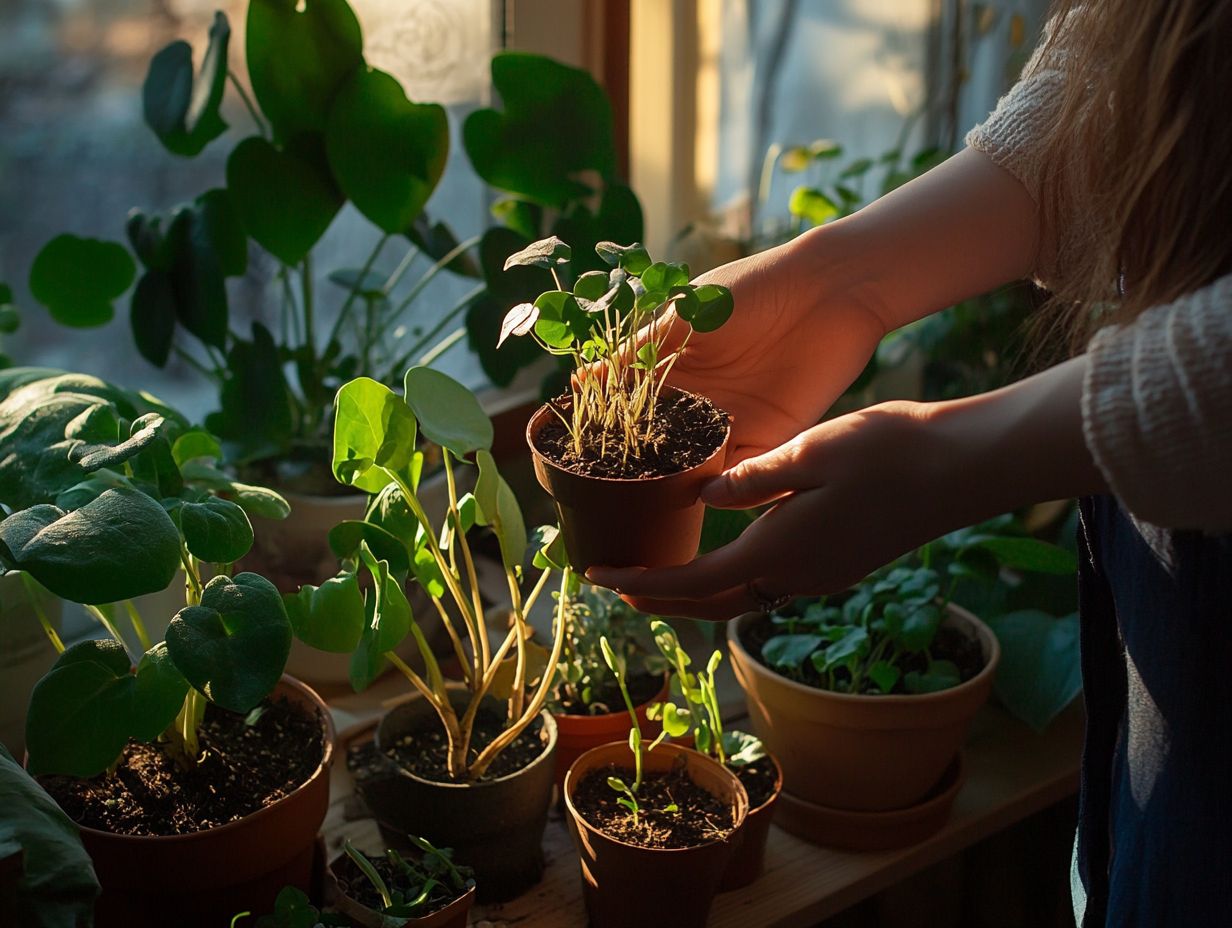
One major benefit of plant propagation is preventing plant extinction! This allows gardeners to cultivate rare species. You can create a large number of plants from a single parent plant while maintaining genetic diversity and propagating rare or hard-to-find plants.
What are the different methods of plant propagation?
Many gardeners set up propagation stations to maximize their propagation efforts, using both sexual and asexual methods. Sexual propagation involves using seeds, while asexual propagation uses vegetative parts of a plant, such as cuttings, division, and layering.
How does plant propagation contribute to sustainable gardening?
You can grow your own plants with ease! This reduces the need to purchase new plants, which may introduce pests or diseases. It also helps preserve rare and endangered plants through propagation.
What are the advantages of asexual plant propagation?
Asexual plant propagation allows for creating genetically identical plants. This ensures desirable traits and characteristics are maintained while promoting faster growth and maturity of plants compared to starting from seeds.
Can beginners try plant propagation?
Yes, beginners can absolutely try plant propagation! Methods such as taking cuttings or dividing plants are relatively easy and can be successful with minimal knowledge or experience. There are many resources and guides available for beginners to learn more about plant propagation.
Ready to grow your garden? Let s get started on plant propagation today!


